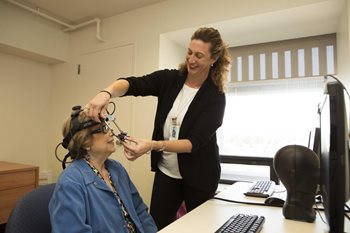Eye Tracking
Eye tracking entails monitoring where a person looks, when and for how long, to assess their cognitive function. Scientists at the Rotman Research Institute (RRI) have pioneered the use of eye tracking as a tool to understand memory, including how memory changes with age or with neurological problems.
 Some of the traditional tests used to diagnose memory impairments rely heavily on language. This can pose problems, for instance, if the person is not fluent in the language being used. Eye tracking offers an alternative, allowing researchers to monitor cognition without relying on language. This could ultimately lead to the development of better screening tools for dementia, allowing healthcare practitioners to prescribe interventions earlier to help preserve cognitive function or slow decline.
Some of the traditional tests used to diagnose memory impairments rely heavily on language. This can pose problems, for instance, if the person is not fluent in the language being used. Eye tracking offers an alternative, allowing researchers to monitor cognition without relying on language. This could ultimately lead to the development of better screening tools for dementia, allowing healthcare practitioners to prescribe interventions earlier to help preserve cognitive function or slow decline.
Learn more about Baycrest research that uses eye tracking:
Our eye movements help us retrieve memories, suggests a new Baycrest study
The eyes tell all about memory: Link between what we see and how we remember ‘breaks’ as we get older
-
Click here for more information on Baycrest’s eye tracking facilities
The RRI has several stand-alone SR Research EyeLink eye trackers (
https://www.sr-research.com/), including two head-mounted EyeLink II systems, two EyeLink Portable Duos and one EyeLink 1000. The MRI, MEG and EEG suites are also equipped with EyeLink 1000s. The EyeLink systems provide fast, accurate and reliable tracking of eye movements during viewing of static and dynamic images, during reading and even in the absence of any visual stimulation.